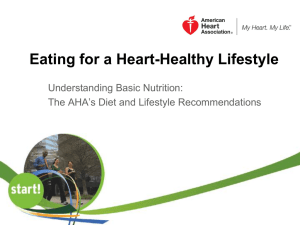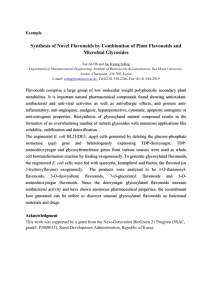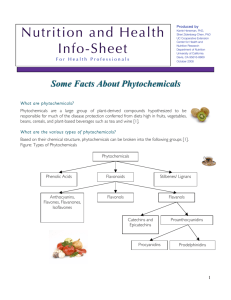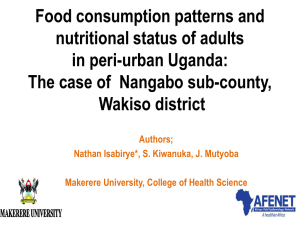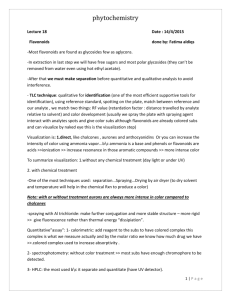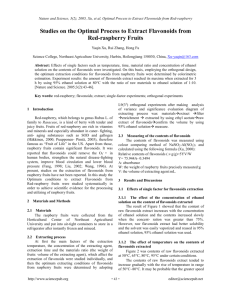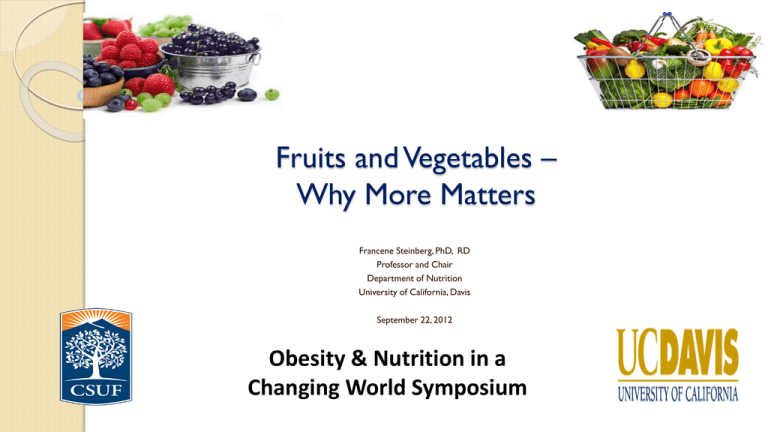
Fruits and Vegetables –
Why More Matters
Francene Steinberg, PhD, RD
Professor and Chair
Department of Nutrition
University of California, Davis
September 22, 2012
Obesity & Nutrition in a
Changing World Symposium
Learning Objectives
Learners will:
Gain an understanding of usual fruit & vegetable
intake
Be able to define the term dietary “phytonutrient”
or “flavonoid “
Be able to describe the association between fruit &
vegetable intake, and positive health outcomes
(reduction of chronic disease risk)
Be able to describe possible mechanisms for how
phytonutrient –rich foods promote health
Be aware of challenges to implement successful
interventions to increase fruit & vegetable intake in a
Fruit & Vegetable Intake –
US Trends 1988-2002
• 10.8% of population eating ≥2 Fruit & ≥3 Vegetable servings
• 23.6% of population eating ≥5 of any Frt/Veg combination
Casagrande et al. Am J Prev Med 2007 32:257
Fruits & Vegetables and
Chronic Disease Risk
Strong & convincing evidence of ↑ F/V consumption
leading to ↓ risk of the following diseases:
◦ Hypertension, Coronary Heart Disease, Stroke
Probable evidence:
◦ Cancer, Type 2 diabetes (indirectly through weight control)
Possible evidence:
◦ Obesity, Macular degeneration, Dementia, Asthma & COPD
Insufficient evidence:
◦ Inflammatory bowel diseases, diabetic retinopathy
Slavin & Lloyd 2012 Adv Nutr 3:506
Boeing et al 2012 Eur J Nutr epub ahead of press
Fruits and Vegetables Decrease Cardiovascular Disease
Risk & Clinical Outcomes
Multivariate adjusted* Relative Risk for
Frt/Veg consumption ≥ 3 times/day
vs. <1 time/day
- Ischemic heart disease mortality
RR=0.76 (95% CI: 0.56, 1.03)
- CVD mortality RR=0.73 (95% CI: 0.58,
0.92)
- All cause mortality RR=0.85 (95% CI:
0.72, 1.00)
*adjusted for age, sex, race, energy, physical activity, alcohol
consumption, smoking, plus others
Bazzano et al AJCN 2002; 76, 93-99
Cross-sectional studies using
biomarker outcomes
F/V intake is correlated with improved inflammatory status in a community
setting
◦ N=1000, 18-85 y, food intake assessed & blood samples taken
◦ Inverse relationship of inflammatory markers with increasing F/V intake
◦ Root et al. Nutrients 2012
F/V consumption is related to makers of inflammation and oxidative stress
in adolescents
◦ N=285, 13-17 y, food intake assessed & blood samples taken
◦ Inverse relationship of inflammatory markers with increasing F/V intake
◦ Holt et al. JADA 2009
Fruits & Veggies contain…
Vitamins (C, Folate, etc.)
Minerals (Potassium, Magnesium, etc.)
Fiber (mostly soluble)
Bioactive compounds
◦ Not traditional nutrients
◦ Have biologic activities
Examples: Carotenoids (such as lutein, zeaxanthin, lycopene, etc.);
Phytochemicals (such as various phenolic compounds – ellagic acid,
quercetin, anthocyanidins, etc.)
Dietary Phytochemicals
Phytochemicals are a broad and diverse group of phenolic compounds
that are produced in and accumulate in plants.
Phytochemical rich foods include: fruits and vegetables, some cocoa
products, as well as whole grains and beverages such as tea & wine.
Phytochemicals can alter metabolic & cellular processes.
Most dietary studies indicate that diets rich in phytochemicals are
associated with improved health and provide protection against chronic
diseases, or alter in a positive direction markers for chronic disease.
Phytochemical Nomenclature
Polyphenols
Phenolic
Acids
Flavonoids
C6-C3-C6 skeleton
Others
Anthocyanins
(red pigment in berries
and other fruits)
Flavonols
Flavanols
(quercetin: onions,
tomatoes)
(catechin: tea, cocoa,
apples)
Monomers
Monomers
Isoflavones
soy
(genistein, daidzein)
Others
(stilbenes, ligans)
Proanthocyanidins
Oligomers of Flavanols
Catechin/Epicatechin
(cocoa, tea, apples, peanuts)
Questions about health promoting
effects of food flavonoids
Important issues:
◦ Are the phytochemicals absorbed & do they get to target tissues? How
much is absorbed?
◦ What is the best model to study the effects in?
◦ What are the biologic effects on key markers of function or health? (or
disease risk)
◦ Is the effect the same in healthy or at risk individuals?
◦ What is/are the specific bioactive component(s)?
◦ How can you monitor intake after consuming the food?
◦ What are the implications for human health? Should there be specific
Dietary Flavonoids
Estimated intake: 0.01-1.0 g/day
Major Dietary sources:
◦ Fruits and vegetables such as apple, grapes,
onion: rich in flavonols, (quercetin,
anthocyanidin, kaempferol)
◦ Citrus fruits: rich in flavanols (hesperidin and
naringenin)
◦ Soy: rich in isoflavones (Genistein and
Daidzein)
Absorption, Distribution, Metabolism, Excretion
(ADME) – Factors which impact biologic effects
of phytochemicals
Intake of phytochemical or precursor does not automatically
equate with exposure at tissue level
Inter-individual differences
◦ Transport across intestinal wall
◦ Biotransformation enzymes (phase I & II) genetic differences & effects of
other endogenous or xenobiotic compounds
◦ Intestinal Microbiota
◦ Gut transit
◦ Age, gender, physiologic state
Diet, food matrix, chemical nature of polyphenol
Metabolism of Flavonoids
Absorbed mainly in aglycone form, possibly some glycosides
Peak blood levels occur within 1 to 2.5 hours, or up to 8 hours for
some compounds
Plasma concentration in 1-5 mmol/L range
Circulate in blood as conjugated metabolites (glucuronides and
methylated or sulfated)
Can be partially metabolized by gut microbes
Elimination half-life of 23 to 28 hours
Urinary excretion
Bioavailability of 20% +/-
Dietary polyphenols have been postulated to
modulate the development and progression of
several chronic diseases:
Age related vision loss
Osteoporosis
Obesity
•
•
•
•
Hypertension
Cardiovascular disease
Diabetes
Cancer
Age-Adjusted CHD Mortality, %
Flavonoid Intake and Risk of CHD Mortality
35
30
25
20
15
10
5
0
0
10
20
30
40
50
60
70
80
Mean Flavonoid Intake (mg/day)
Hertog et al. Arch Intern Med 155: 381-386, 1995
Flavonoids, Flavonoid-rich Foods
& Chronic Disease Risk
AJCN 2008 Hooper et al. – Meta-Analysis of 133 RCT of various flavonoid food
sources on CVD risk
◦ Green tea ( LDL), cocoa ( FMD), soy protein ( LDL)
◦ Clinically relevant changes observed
AJCN 2007 Mink et al. – Flavonoids and CVD mortality in Iowa Women’s Health Study
◦ Found RR for highest vs lowest quintile or any intake vs none for classes of flavonoids between
0.78 and 0.91
◦ Individual foods associated w/ risk reduction included bran, apples, pears, red wine, grapefruit,
strawberries, chocolate
Int J Cancer 2008 Cutler et al. – Flavonoids and Cancer Risk in Iowa Women’s Health
Study
◦ Isoflavone intake inversely associated w/ overall cancer incidence
◦ Lung cancer incidence inversely associated w/ flavanones & proanthocyanins. Strongest effect in
current & past smokers
Nutr Rev 2012 Peterson et al. – Associations between flavonoids and cardiovascular
Comments on Epidemiologic vs Clinical Trials for
Investigating Health Effects of Flavonoids
Observational Epidemiologic studies can confirm or negate theories about
importance of flavonoids in the diets of free-living individuals
◦ Useful to evaluate human health effects of long-term exposure to physiologic
concentrations of flavonoids
◦ Cannot prove causality
◦ Reliable data on flavonoid contents of foods not available for all classes
◦ Correlations between flavonoids & other food components is high, therefore difficult
to conclude association truly exist w/ the flavonoid alone
RCT – human clinical studies
◦ Aimed at demonstrating physiologic phenomenon in response to foods or to
isolated food flavonoid components
◦ Important to consider synergisms of food components & other foods in total diet
◦ Help to identify potential mechanistic functions
Phytochemicals (Flavonoids) - Potential Targets and
Mechanisms of Action
Cellular & Molecular Targets
◦ Enzyme inhibition or activation
◦ Modulation of transcription factors, nuclear
receptors & gene expression
◦ Modulation of inflammatory response
◦ Antioxidant action
◦ Cell cycle regulation
◦ Competition with endogenous substrates for
receptors
◦ Modulation of cell signaling pathways
◦ Other….
“Let food be thy medicine
and medicine be thy food”
Hippocrates
The Father of Medicine
460 BC – 377 BC
The public is embracing the concept
of --“food as medicine” in response to
the evolving health care crisis that is
occurring in most developed
countries.
The goal of “optimal health” is
desired by many, but the promise of
the “optimal diet” and “miracle” or
“super foods” is often more attractive
than the recommendation of a
balanced diet rich in fruits, vegetables
and plant foods.
How to achieve higher fruit &
vegetable intakes; what is effective for
Dietary Patterns -Examples of diet patterns rich in food
phytochemicals…number of F/V servings is ≥
typical USDA dietary guidelines or the American
Heart Association recommendations:
DASH diet
Mediterranean diet
DASH Diet
Dietary Approaches to Stop Hypertension
Control American Diet
(37% total fat, 3.6 serv F/V,
2.5 serv meat, 0.4 serv dairy)
Fruit/Vegetable Diet
(37% total fat, 8.5 serv F/V,
2.5 serv meat, 0.3 serv dairy,
0.6 serv nuts)
DASH Diet
(27% total fat, 9.6 serv F/V,
1.6 serv meat, 2 serv low fat dairy,
0.7 serv nuts)
Outcomes:
Change in Blood Pressure: 5.5 mm HG systolic, 3.0 mm Hg
diastolic on the Dash diet, intermediate results on F/V diet
Examples from PREDIMED
Trial
Prevencion con Dieta Mediterranea
Large (n=7,447) multicenter European trial of
individuals with risk factors but free of CVD. 3 diet
arms Med+VOO, Med+nuts, Low fat. Followed
multiple years
Decreased cellular & circulating
inflammatory biomarkers related to
cardiovascular risk (Med diet vs Low fat
diet) 2012 Pharamcol Res
Beneficial changes in apolipoproteins B, A1 and their ratio (Med diet vs Low fat diet)
2011 Atherosclerosis
Reduced diabetes incidence (up to 52% ↓).
After 4 yr follow-up, incidence of T2DM
was 10.1% vs 17.9% (Med diet vs Low fat).
2011 Diabetes Care
Predictors and Barriers of
Fruit & Vegetable Intake
Predictors
◦ Favorable taste preferences
◦ F>M
◦ ↑ Age
◦ ↑ SES
◦ ↑ Educational status attained
Barriers
◦ Cost
◦ Limited access
◦ Time to prepare foods
◦ Unfamiliarity with certain foods
Conclusions
Scientific evidence supports chronic disease risk reduction related to
F/V consumption, in some but not all conditions
Health benefits of F/V appear to be associated with food
phytochemicals, such as polyphenolic flavonoids, in addition to traditional
nutrients
Flavonoids are absorbed, metabolized & reach target tissues
Mechanisms of biologic action for flavonoids are multifactorial & involve
cellular events
Benefits are seen with intake levels for F/V higher than USDA
recommendations, and as part of a healthful diet pattern
Average intake of F/V is low and has not changed much over last 20
years. Significant challenges exist regarding the goal of increasing

